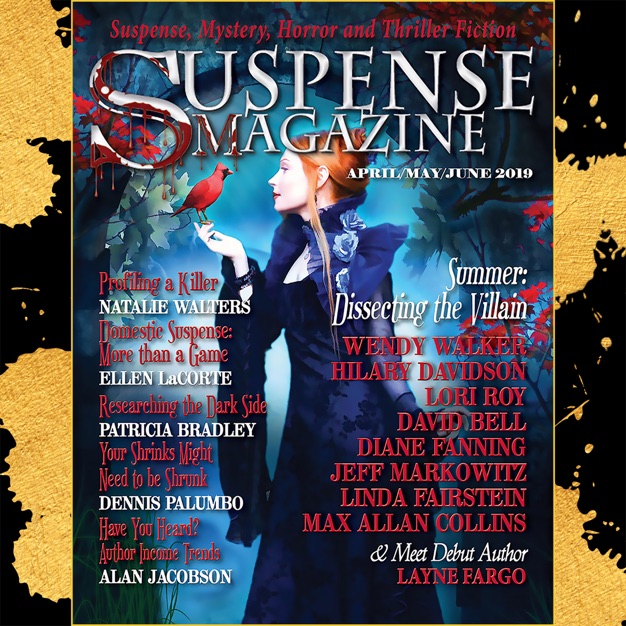
Suspense Radio
www.suspensemagazine.com
Suspense Radio, brings you the best of the best in suspense / thriller / mystery and horror. Interviews and reviews in the genres.
- 27 minutes 11 secondsCriminal Mischief Episode 26: Storytelling in Dixie
Here’s the thing about the South—if you can’t tell a story, they won’t feed you. They’ll simply deposit you behind the barn and let you wither away. That doesn’t happen often because everyone down there can spin a yarn. Some better than others, but a story is a story. This is a rich tradition and congers up names like William Faulkner, James Dickey, Eudora Welty, Flannery O’Conner, Tennessee Williams, Mark Twain, Harper Lee, Truman Capote (who spent much of his childhood in Alabama), James Lee Burke, and the list goes on and on.
Where did this tradition come from? Since much of the South was settled by Scotch- Irish immigrants, they transported their storytelling skills across the pond. Ever hear of a Scotsman who couldn’t reel off a story over a few glasses of whiskey? Me, either. Plus, the South was rural, poor, and with fewer resources, so much of society revolved around the farm, and hearth and home. Books were a luxury, meaning that family entertainment came from stories told by the fireplace.
I grew up in Alabama. Huntsville to be exact. Not your typical southern town. Sure we had acres of farmland, churches on every corner, enough pickup trucks to cause a traffic jam, and a cacophony of country music, but we also had a space program. Snuggled up to the city is NASA’s Marshall Space Flight Center where Werner von Braun and cohorts built the rockets that sent men into orbit and eventually to the surface of the moon. Made for an interesting soup of folks. Rednecks and scientist, all dining on barbecue and biscuits, and of course pecan pie.
So, what is it that makes Southern storytelling so compelling? It’s the many facets of the area. You can’t write about the South without considering country music, the blues, country stores, cornbread, sweet tea, and the weather.
Weather: Weather is a character in Southern stories. The rain, the hair-raising electrical storms, and, of course, the heat and humidity conspire to alter everything in life. The cracking of lightning puts nerves on edge while the sauna-like air wilts your clothing, slows your walk, and stretches out your drawl like back strap molasses creeping over a mess of hotcakes. In his famous “Ten Rules of Writing,” Elmore Leonard admonished authors to never start a story with the weather. He forgot to tell that to James Lee Burke. His Dave Robicheaux series moves around the swamplands of Louisiana, a place where weather is most definitely a character. Don’t believe it. Read the first paragraph of his Edgar Award-winning Black...
22 November 2024, 6:55 pm - 21 minutes 4 secondsInterview with Marcia Clark
We are so honored to bring you ex-criminal prosecutor and current bestselling author Marcia Clark. She joins us to talk about her latest book, TRIAL BY AMBUSH, her first True Crime novel.
Marcia Clark is the best selling author of nine legal thrillers and one memoir, starting with four bestselling legal thrillers featuring prosecutor Rachel Knight: The Competition, Killer Ambition, Guilt by Degrees, and Guilt by Association. TNT optioned the books for a one-hour drama series and shot the pilot, which starred Julia Stiles as Rachel Knight.
Her most recent series features criminal defense attorney Samantha Brinkman and includes Blood Defense, Moral Defense, Snap Judgment, and Final Judgment. Marcia’s latest thriller, released in September 2022, The Fall Girl, was a standalone featuring two leads with alternating chapters. Marcia narrated the audiobook along with TV writing partner, Catherine LePard.
19 November 2024, 9:31 pm - 35 minutes 19 secondsCriminal Mischief Episode 25: Stroll Through Forensic History
SHOW NOTES:
FORENSIC
SCIENCE TIMELINEPrehistory: Early cave
artists and pot makers “sign” their works with a paint or impressed finger or
thumbprint.1000 b.c.: Chinese use
fingerprints to “sign” legal documents.3rd century BC.:
Erasistratus (c. 304–250 b.c.) and Herophilus (c. 335–280 b.c.) perform the
first autopsies in Alexandria.2nd century AD.: Galen
(131–200 a.d.), physician to Roman gladiators, dissects both animal and humans
to search for the causes of disease.c. 1000: Roman attorney
Quintilian shows that a bloody handprint was intended to frame a blind man for
his mother’s murder.
1194: King Richard
Plantagenet (1157–1199) officially creates the position of coroner.
1200s: First forensic
autopsies are done at the University of Bologna.
1247: Sung Tz’u publishes
Hsi Yuan Lu (The Washing Away of Wrongs), the first forensic text.
c. 1348–1350: Pope Clement
VI(1291–1352) orders autopsies on victims of the Black Death to hopefully find
a cause for the plague.
Late 1400s: Medical
schools are established in Padua and Bologna.
1500s: Ambroise Paré
(1510–1590) writes extensively on the anatomy of war and homicidal wounds.
1642: University of
Leipzig offers the first courses in forensic medicine.
1683: Antony van
Leeuwenhoek (1632–1723) employs a microscope to first see living bacteria,
which he calls animalcules.
Late 1600s: Giovanni
Morgagni (1682–1771) first correlates autopsy findings to various diseases.
1685: Marcello Malpighi
first recognizes fingerprint patterns and uses the terms loops and whorls.
1775: Paul Revere
recognizes dentures he had made for his friend Dr. Joseph Warren and thus
identifies the doctor’s body in a mass grave at Bunker Hill.
1775: Carl Wilhelm Scheele
(1742–1786) develops the first test for arsenic.
1784: In what is perhaps
the first ballistic comparison, John Toms is convicted of murder based on the
match of paper wadding removed from the victim’s wound with paper found in
Tom’s pocket.
1787: Johann Metzger
develops a method for isolating arsenic.19 November 2024, 9:20 pm - 23 minutes 50 secondsCriminal Mischief Episode 24: Common Writing Mistakes
SHOW NOTES:
Writers, particularly early in their careers, make mistakes. Often the
same ones over and over. Here are a few pitfalls to avoid.
OVERWRITING:Too many words
Too cute by far
Strained Metaphors
Purple prose
DIALOG:Tag alert
Characters all sound the same
Inane conversations
“As you know” chatting
SHOW VS TELL:
DESCRIPTION:Not too much
Not too little
Just enough—the telling details
SCENES:In and Out quickly—in medias res
Leave question/tension at end
POV:Stay in one at a time
Except Omniscient—hard to do
PACING:
Fast but not too fast
Vary pace
BACKSTORY:How much?
When?
ENTERTAIN:
19 November 2024, 7:18 pm - 27 minutes 7 secondsCriminal Mischief Episode 23: Apollo 11 and Me
SHOW NOTES:
It’s hard to believe that it’s been 50 years. Exactly 50 years.
This show has nothing to do with crime writing or the science of crime. It is rather a step back in world history. And in my personal history. Yes, I was there. Inside the gates of the Cape Canaveral Space Center. July 16, 1969, 9:32 a.m. I remember it like it was yesterday. Please indulge me and join me for this trip down memory lane.
The above picture is more or less the view I had of the launch. The sky was clear, the tension thick, and not a dry eye to be found.
19 November 2024, 7:12 pm - 24 minutes 36 secondsCriminal Mischief Episode 22: Common Medical Errors in Fiction
Too often, fiction writers commit medical malpractice in their stories. Unfortunately, these mistakes can sink an otherwise well-written story. The ones I repetitively see include:
Bang, Bang, You’re Dead: Not so fast. No one dies instantly. Well, almost no one. Instant death can occur with heart attacks, strokes, extremely abnormal heart rhythms, cyanide, and a few other “metabolic” poisons. But trauma, such as gunshot wounds (GSWs) and blows to the head, rarely cause sudden death. Yet, how often has a single shot felled a villain? Bang, dead. For that to occur, the bullet would have to severely damage the brain, the heart, or the cervical (neck) portion of the spinal cord. A shot to the chest or abdomen leads to a lot of screaming and moaning, but death comes from bleeding and that takes time. Sometimes, a long time.
Ask any emergency physician or nurse. GSW victims reach the ER with multiple holes in their bodies and survive all the time. This is particularly true if it’s Friday night (we called it the Friday Night Knife and Gun Club), during a full moon (yes, it’s true, a full moon changes everything), or if the victim is drunk. You can’t kill a drunk. That’s a medical fact. They survive everything from car wrecks to gunshots to falling off tall buildings. The family van they hit head-on will have no survivors, but the drunk will walk away with minor scratches, if that.
Sleeping Beauty: I call this the “Hollywood Death.” Calm, peaceful, and not a hair out of place. As if simply asleep. Blood? Almost never. Trauma? None in sight. The deceased is nicely dressed, stretched out on a wrinkle-free bed, make-up perfect, and with a slight flutter of the eyelids if you look closely. Real dead folks are not so attractive. I don’t care what they looked like during life, in death they are pale, waxy, and gray. Their eyes do not flutter and they do not look relaxed and peaceful. They look dead. And feel cold. It’s amazing how quickly after death the body becomes cold to the touch. It has to do with the loss of blood flow to the skin after the heart stops. No warm blood, no warmth to the touch.
Sleeping Beauty also doesn’t bleed. You know this one. The hero detective arrives at a murder scene a half hour after the deed to see blood oozing from the corpse’s mouth or from the GSW to the chest. Tilt! Dead folks don’t bleed. You see, when you die, your heart stops and the blood...
19 November 2024, 6:32 pm - 25 minutes 53 secondsCriminal Mischief Episode 21: Autopsy of a Thriller, The Terminator
SHOW NOTES:
A scene-by-scene analysis of The Terminator
Each scene is either good (+), Bad (-) or Neutral (0) for Sarah Conner, the protagonist.
Watch the movie and rate each scene. You will see that through the first 2/3s of the film things don’t go well for Sarah but she overcomes seemingly insurmountable odds to win in the end.
This is how a good thriller is plotted.
The Terminator (1984)
T = The Terminator
R = Kyle Reese
S = Sarah Conner
19 November 2024, 6:24 pm - 28 minutes 35 secondsCriminal Mischief Episode 20: Elements of a Thriller
SHOW NOTES:
Elements of a Thriller
Open with a Bang or a Chill or a Compelling Question
Establish the 4 Ws Early-------Who, What, When, and Where
Inciting Incident---Sets the protagonist’s story in motion
Establish the Story Question—What does the Protagonist want/need?
Rising Tension
Who/What opposes the Protagonist and Why?
What does the antagonist want/need?
Establish a Time or Situation Endpoint
Scenes advance or obstruct the protagonist’s attaining goal
Each power scene poses a question and ends with:
Yes------------------------------Weak
No-------------------------------Better
Yes, but------------------------Strong
No, and further more———————————-Strongest
Convergence of Space and Time—“Life in a Trash Compactor”
Epiphany---Protagonist grasps the solution
Personal Jeopardy---Protagonist must fear for personal safety
Mano a’ Mano---Protagonist must confront antagonist “face to face”
Resolution---all major story questions are resolved13 November 2024, 10:06 pm - 15 minutes 45 secondsCriminal Mischief Episode 19: SUNSHINE STATE is coming
From Publishers Weekly:
In Lyle’s ingenious third mystery featuring retired major league pitcher Jake Longly (after 2017’s A-List), Jake, who runs a restaurant in Gulf Shores, Ala., is again roped into working for his father Ray’s PI firm. An attorney has contacted Ray on behalf of Billy Wayne Baker, a convicted serial killer. Though Baker pleaded guilty to strangling seven women, he insists that he killed only five of them, and wants that assertion validated. When Jake meets Baker in prison, the murderer refuses to name the other killer, claiming that doing so would lead to accusations that Jake’s inquiries were biased. The investigator’s task is made even harder by Baker’s not even identifying which of the dead women were killed by someone else . (To his credit, Lyle makes this complicated scenario credible.) Along with his girlfriend, Jake travels to Pine Key, Fla., the scene of three of the strangulations, where the couple pretend to be researching a documentary examining the impact of the killings on the small community. The clever plot twists will surprise even genre veterans. This entry is the best in the series so far.
13 November 2024, 10:01 pm - 26 minutes 39 secondsCriminal Mischief Episode 18: Gunshot to the chest
SHOW NOTES:
Gunshot wounds (GSWs) come in many flavors and those to the chest can be particularly dicey. Yet, a chest GSW can be a minor flesh wound, a major traumatic event with significant damage, or deadly. If you have a character who suffers such an injury, this podcast is for you.
Here are few interesting questions about chest GSWs:
Could a Person Survive a Gunshot to the Chest in the 1880s?
Q: My scenario is set in 1880. A man in his early 20s is shot in the back by a rifle. He loses a lot of blood and is found a couple of hours later unconscious. Could he survive and if
so how long would it take him it recuperate? Also, would it be possible to
bring him to consciousness long enough for another man to get him into a buggy.
Is any part of this scenario possible?
A: Everything about your scenario works. A gun shot wound (GSW) to the chest can kill in minutes, hours, days, or not at all. The victim would be in pain and may cough and sputter and may even cough up some blood. He could probably walk or crawl and maybe even fight and run if necessary. Painful, but possible. He would likely be
consciousness so could even help get himself into the wagon.If all goes well, he should be better and gingerly up and around in a week or two. He would be fully recovered in 6 to 8 weeks.
After surviving the initial GSW, the greatest risk to his life would a secondary wound infection. Since no antibiotics were available at that time, the death rate was very high---40 to 80 percent---for wound infections. But, if he did not develop an infection, he would heal up completely.
How Is A Gunshot To The Chest Treated?
Q: I have a few questions regarding a gunshot wound that my poor character
will be sustaining later on in my story. Supposing it's a fairly small caliber
bullet (typical handgun fare, not buckshot or anything) and it hits near the
heart without puncturing anything important, how long might his recovery time
be? He's a strong, kinda-healthy guy in his thirties, although he drinks a fair
amount and used to smoke. He'll be rushed to a high-quality hospital
immediately and receive the best care throughout recovery...what's his outlook?
When will he be allowed to go home, if all goes well? How long before he's
healed to normal? When will it be safe for him to walk around, drive, have sex,
etc.?
A: In your story, what happens to your shooting victim depends upon what injuries he received. A gunshot wound (GSW to docs and cops) can be a minor flesh wound or can be immediately deadly or anywhere in between. It all depends on the caliber and
speed of the bullet and the exact structures it hits. A shot to the heart may
kill instantly or not. The victim could die in a few minutes or survive for
days or could recover completely with proper medical care and surgery. It’s
highly variable but ask any surgeon or ER doctor and they will tell you that
it’s hard to...13 November 2024, 9:58 pm - 24 minutes 41 secondsCriminal Mischief Episode 17: DNA and Twins
SHOW NOTES:
For years it was felt that the DNA of identical twins was indeedidentical. Since they come from a single fertilized egg, this would seem intuitive. But, nature likes to throw curve balls—and the occasional slider. After that first division of the fertilized, and after the two daughter cells go their way toward producing identical humans, things change. And therein lies the genetic differences between two “identical” twins.
LINKS:
One Twin Committed the Crime—but Which One?: https://www.nytimes.com/2019/03/01/science/twins-dna-crime-paternity.html
The Claim: Identical Twins Have Identical DNA: https://www.nytimes.com/2008/03/11/health/11real.html
The Genetic Relationship Between Identical Twins: https://www.verywellfamily.com/identical-twins-and-dna-2447117
Identical Twins’ Genes Are Not Identical: https://www.scientificamerican.com/article/identical-twins-genes-are-not-identical/
Rare Australian Twins Are “Semi-Identical,: Sharing 89 Percent of Their
DNA: https://www.inverse.com/article/53633-semi-identical-twins-share-78-percent-of-dna13 November 2024, 9:51 pm - More Episodes? Get the App
Your feedback is valuable to us. Should you encounter any bugs, glitches, lack of functionality or other problems, please email us on [email protected] or join Moon.FM Telegram Group where you can talk directly to the dev team who are happy to answer any queries.
 Meet the Thriller Author: Interviews with Writers of Mystery, Thriller, and Suspense Books
Meet the Thriller Author: Interviews with Writers of Mystery, Thriller, and Suspense Books
 Writer Types
Writer Types
 Thriller Radio with Joshua Graham
Thriller Radio with Joshua Graham
 Authors on the Air Radio 2
Authors on the Air Radio 2
 Suspense and Horror – Retro Radio Podcast
Suspense and Horror – Retro Radio Podcast
 KPFA - Suspense
KPFA - Suspense